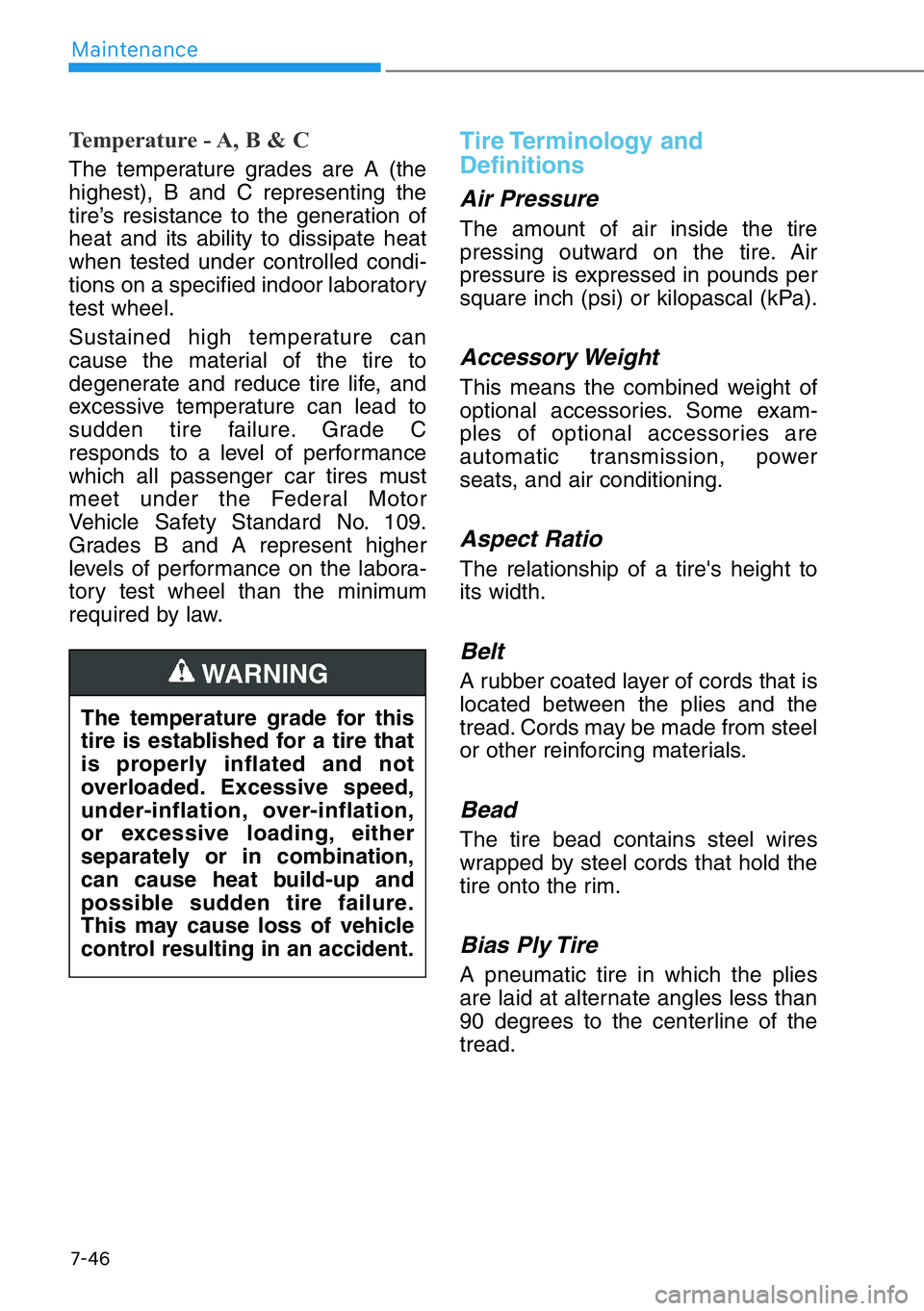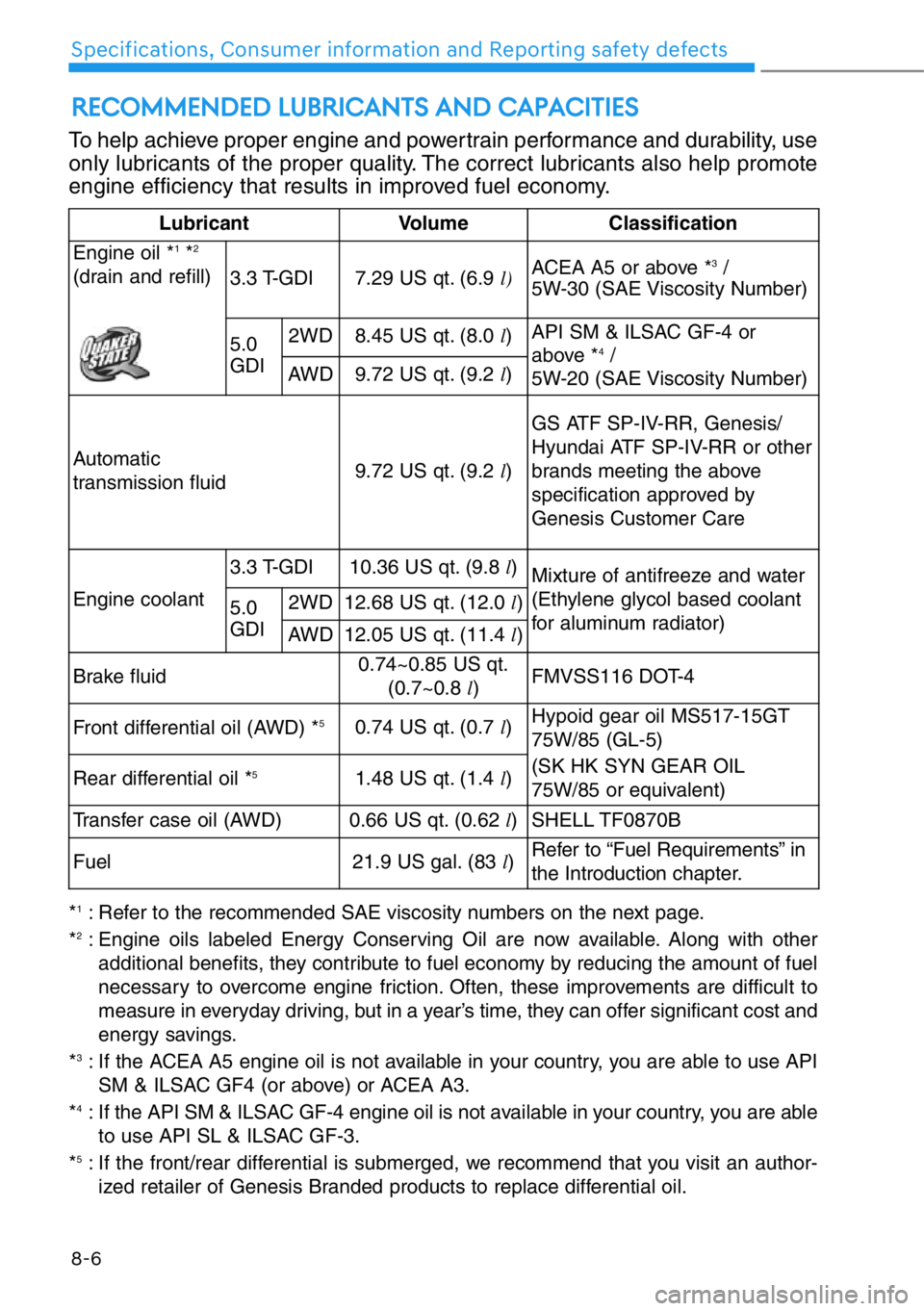Page 461 of 538

7-21
07
Brake Hoses and Lines
Visually check for proper installation,
chafing, cracks, deterioration and
any leakage. Replace any deteriorat-
ed or damaged parts immediately.
Brake Fluid
Check the brake fluid level in the
brake fluid reservoir. The level should
be between the MIN and the MAX
marks on the side of the reservoir.
Use only hydraulic brake fluid con-
forming to DOT 4 specification.
Brake Transmission Fluid
Check the pads for excessive wear,
discs for run out and wear, and
calipers for fluid leakage.
Exhaust Pipe and Muffler
Visually inspect the exhaust pipes,
muffler and hangers for cracks, dete-
rioration, or damage. Start the
engine and listen carefully for any
exhaust gas leakage. Tighten con-
nections or replace parts as neces-
sary.
Suspension Mounting Bolts
Check the suspension connections
for looseness or damage. Retighten
to the specified torque.
Steering Gear Box, Linkage &
Boots/Lower Arm Ball Joint
With the vehicle stopped and the
engine off, check for excessive free-
play in the steering wheel. Check the
linkage for bends or damage. Check
the dust boots and ball joints for
deterioration, cracks, or damage.
Replace any damaged parts.
Drive Shafts and Boots
Check the drive shafts, boots and
clamps for cracks, deterioration, or
damage. Replace any damaged
parts and, if necessary, repack the
grease.
Air Conditioning Refrigerant
Check the air conditioning lines and
connections for leakage and dam-
age.
Page 486 of 538

7-46
Maintenance
Temperature - A, B & C
The temperature grades are A (the
highest), B and C representing the
tire’s resistance to the generation of
heat and its ability to dissipate heat
when tested under controlled condi-
tions on a specified indoor laboratory
test wheel.
Sustained high temperature can
cause the material of the tire to
degenerate and reduce tire life, and
excessive temperature can lead to
sudden tire failure. Grade C
responds to a level of performance
which all passenger car tires must
meet under the Federal Motor
Vehicle Safety Standard No. 109.
Grades B and A represent higher
levels of performance on the labora-
tory test wheel than the minimum
required by law.
Tire Terminology and
Definitions
Air Pressure
The amount of air inside the tire
pressing outward on the tire. Air
pressure is expressed in pounds per
square inch (psi) or kilopascal (kPa).
Accessory Weight
This means the combined weight of
optional accessories. Some exam-
ples of optional accessories are
automatic transmission, power
seats, and air conditioning.
Aspect Ratio
The relationship of a tire's height to
its width.
Belt
A rubber coated layer of cords that is
located between the plies and the
tread. Cords may be made from steel
or other reinforcing materials.
Bead
The tire bead contains steel wires
wrapped by steel cords that hold the
tire onto the rim.
Bias Ply Tire
A pneumatic tire in which the plies
are laid at alternate angles less than
90 degrees to the centerline of the
tread. The temperature grade for this
tire is established for a tire that
is properly inflated and not
overloaded. Excessive speed,
under-inflation, over-inflation,
or excessive loading, either
separately or in combination,
can cause heat build-up and
possible sudden tire failure.
This may cause loss of vehicle
control resulting in an accident.
WARNING
Page 533 of 538

To help achieve proper engine and powertrain performance and durability, use
only lubricants of the proper quality. The correct lubricants also help promote
engine efficiency that results in improved fuel economy.
RECOMMENDED LUBRICANTS AND CAPACITIES
8-6
Specifications, Consumer information and Reporting safety defects
Lubricant Volume Classification
Engine oil *
1*2
(drain and refill)
3.3 T-GDI7.29 US qt. (6.9 l)ACEA A5 or above *3/
5W-30 (SAE Viscosity Number)
5.0
GDI2WD8.45 US qt. (8.0 l)API SM & ILSAC GF-4 or
above *4/
5W-20 (SAE Viscosity Number)AWD9.72 US qt. (9.2 l)
Automatic
transmission fluid9.72 US qt. (9.2 l)GS ATF SP-IV-RR, Genesis/
Hyundai ATF SP-IV-RR or other
brands meeting the above
specification approved by
Genesis Customer Care
Engine coolant3.3 T-GDI10.36 US qt. (9.8l)
Mixture of antifreeze and water
(Ethylene glycol based coolant
for aluminum radiator)
5.0
GDI2WD12.68 US qt. (12.0 l)
AWD12.05 US qt. (11.4l)
Brake fluid0.74~0.85 US qt.
(0.7~0.8 l)FMVSS116 DOT-4
Front differential oil (AWD) *
50.74 US qt. (0.7 l)Hypoid gear oil MS517-15GT
75W/85 (GL-5)
(SK HK SYN GEAR OIL
75W/85 or equivalent) Rear differential oil *
51.48 US qt. (1.4 l)
Transfer case oil (AWD)0.66 US qt. (0.62 l)SHELL TF0870B
Fuel21.9 US gal. (83 l)Refer to “Fuel Requirements” in
the Introduction chapter.
*1: Refer to the recommended SAE viscosity numbers on the next page.
*2: Engine oils labeled Energy Conserving Oil are now available. Along with other
additional benefits, they contribute to fuel economy by reducing the amount of fuel
necessary to overcome engine friction. Often, these improvements are difficult to
measure in everyday driving, but in a year’s time, they can offer significant cost and
energy savings.
*
3: If the ACEA A5 engine oil is not available in your country, you are able to use API
SM & ILSAC GF4 (or above) or ACEA A3.
*
4: If the API SM & ILSAC GF-4 engine oil is not available in your country, you are able
to use API SL & ILSAC GF-3.
*
5: If the front/rear differential is submerged, we recommend that you visit an author-
ized retailer of Genesis Branded products to replace differential oil.